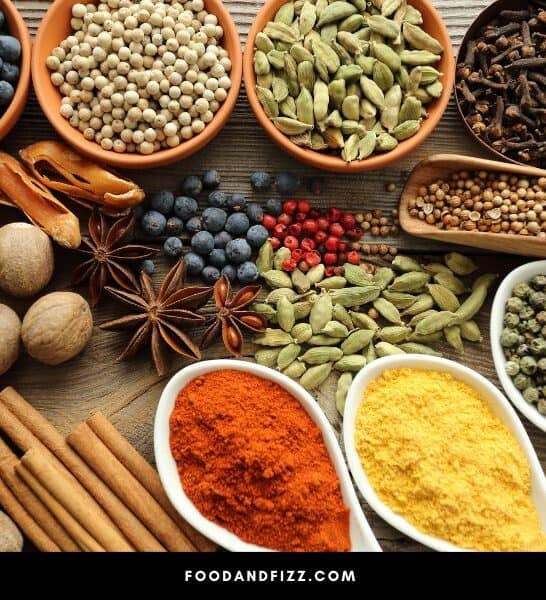The world of food would not be the same without herbs and spices. They bring life, color, and flavor to food, and their specific mix and use brings about the distinctive tastes and identities in different cuisines.
Thai food is known for being spicy, flavorful and pleasantly complex, owing to the liberal and creative use of specific herbs and spices in their cooking.
In this article, we’ll get to know these distinctive spices that make Thai cuisine so recognizable and so memorable.
41 Best Thai Spices
- Lemongrass
- Coriander Root
- Coriander Seeds
- Cilantro or Coriander Leaves
- Cumin
- Cinnamon
- Ginger
- Galangal
- Garlic
- Bird’s Eye Chilis (Prik Kee Noo)
- Prik Mun Chili
- Spur Chili (Prik Chee Fah)
- Karen Chili (Prik Kaleang)
- Dried Chili Flakes (Prik Bon)
- Prik Noom
- Sweet pepper (Prik Yuak)
- Green Peppercorns
- White Peppercorns
- Black Peppercorn
- Thai Long Pepper
- Prickly Ash Seed (Makhwaen)
- Kaffir Lime Leaves
- Holy Basil (Bai Ga Prow)
- Thai Basil (Bai Horapa)
- Lemon Basil (Bai Manglak)
- Pandan
- Thai celery
- Culantro
- Turmeric
- Clove
- Bay Leaves
- Mustard Seeds
- Fenugreek
- Nutmeg
- Onion
- Scallions
- Shallots
- Cardamom
- Star Anise
- Tamarind
- Marsh Mint
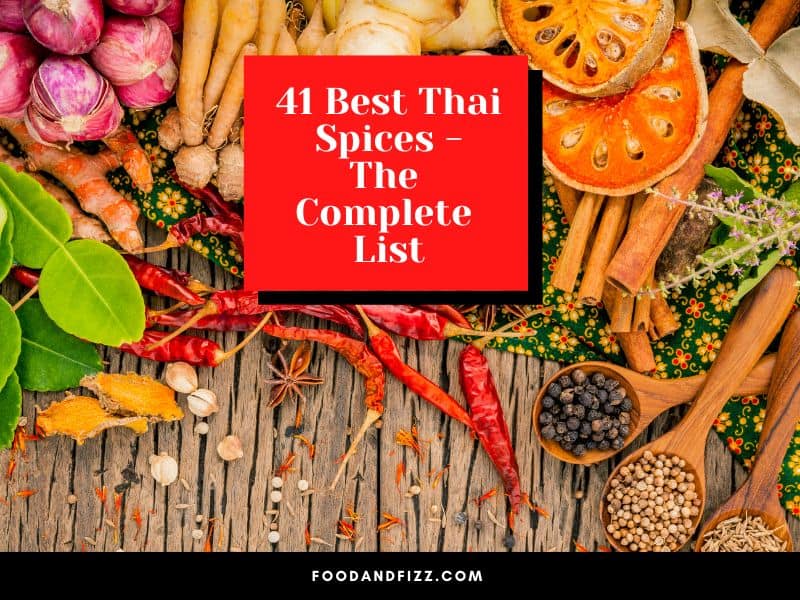
41 Best Thai Spices
1. Lemongrass
Lemongrass is a tall, perennial grass native to Asia, Australia, and Africa. It looks like a sturdy spring onion with a woody stalk and long green leaves, but what sets it apart is its citrus and lemony fragrance. It is widely used in Thai cooking and gives dishes a light, aromatic aroma.
The stalk is mostly used in soups, salads, and curry pastes and integrated into sauces, and the leaves can be used to make tea or herbal infusions.
For soups like Tom Yum Soup, the bottom part of the lemongrass is usually left in larger pieces, but for it to infuse its distinctive flavor, it has to be smashed or pounded first to release the aroma. For things like Green Curry or other types of curry pastes, the stalks are chopped into finer pieces and then blended and pureed to make a paste.
- Characteristics: Long woody stalk with green leaves, aromatic with a citrusy and lemony fragrance
- Flavor or Aroma: Lemon or citrus with a bit of mint
- Uses: Soups like Tom Yum, green curry paste, sauces, herbal teas
- Health Benefits: Antioxidant, anti-bacterial, good for digestion, good for respiratory ailments, alleviates common cold

2. Coriander Root
While in Western cooking, coriander roots are typically discarded, or not even sold to begin with, coriander roots are essential in Asian cooking, especially Thai cooking.
Known as rak phak chi in Thai, it is typically crushed and ground up with a mortar and pestle with garlic and chilis as part of a flavoring base for soups, curries, marinades and dips.
The root is actually the most flavorful and fragrant part of the plant, and the Thais know this and use this knowledge abundantly in preparing dishes.
Coriander roots are very aromatic, and have a slightly peppery flavor, which mellows down when cooked, turning into a subtly sweet flavor.
Its taste is distinct from the stems and the leaves, and there is, unfortunately, no real substitute for the depth that it offers to a dish. It is imperative to wash it prior to using, to get some of the dirt and impurities out of your dish.
- Characteristics: Root of the coriander plant, aromatic
- Flavor or Aroma: Aromatic, slightly peppery flavor. Turns subtly sweet when cooked.
- Uses: Ground up and used in soups, curries, marinades, and dips
- Health Benefits: Antioxidant and anti-inflammatory, promotes heart health

3. Coriander Seeds
Coriander seeds have a warm, earthy, nutty and citrus flavor that’s also slightly spicy. It is typically roasted and ground up into a powder before using in cooking.
Even if they come from the same plant, coriander seeds do not taste anything like the roots, nor its leaves. While the leaves are grassy in flavor, coriander seeds are more earthy and warm. They are used as marinades for meat, and as a part of the spice base of curries like Massaman curry.
- Characteristics: Small and light brown in color
- Flavor or Aroma: Warm, earthy, nutty, slightly spicy and citrusy
- Uses: Roasted and ground up, used as marinades for meat, Massaman curry
- Health Benefits: Helps with skin problems, may reduce cholesterol, prevents allergies and regulates blood pressure
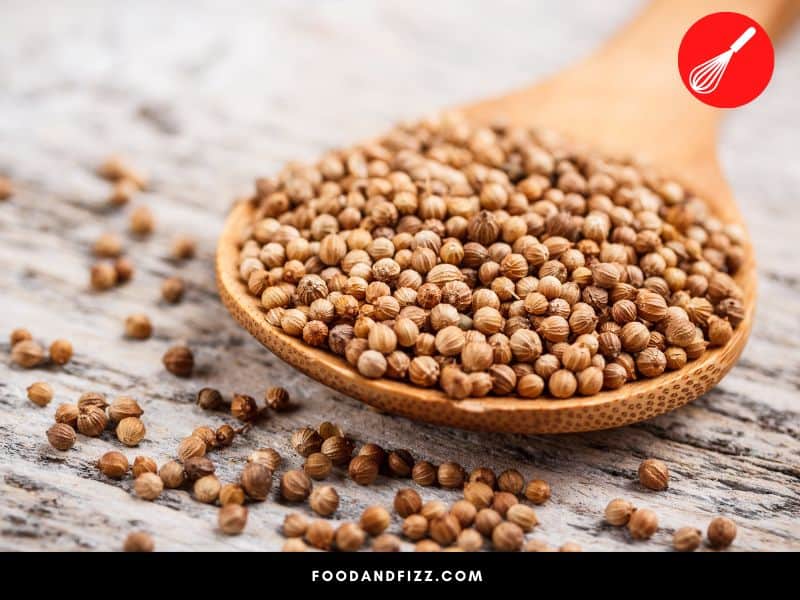
4. Cilantro or Coriander Leaves
Also known as Chinese Parsley, cilantro or coriander leaves are used in Thai cooking as a finishing garnish or as an ingredient in salads and relish.
Because their flavor diminishes with heat, they are typically added to dishes at the end of cooking, or as a topping in the finished dish.
Cilantro has a fresh, grassy and citrusy flavor that adds freshness to a dish, but for some people, they can also taste somewhat soapy and unpleasant. It depends who you ask, but for me, I’m team cilantro! I can add it to anything and eat it with anything!
- Characteristics: Soft delicate green leaves that resemble flat leaf parsley
- Flavor or Aroma: Grassy, pungent and citrusy (or soap-like, for some)
- Uses: Garnish, topping, salads, added towards the end of cooking and prior to serving
- Health Benefits: Detoxifies liver, activates digestive enzymes, helps manage blood sugar, improves kidney function
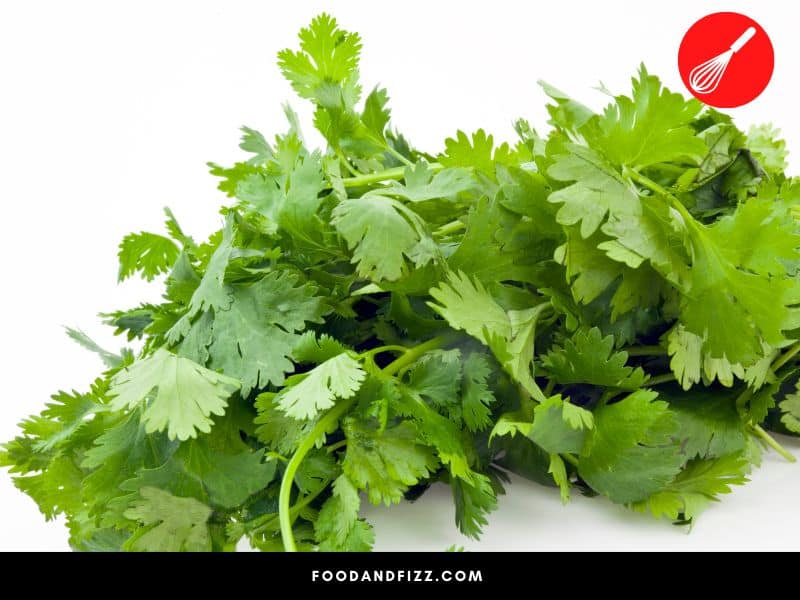
5. Cumin
Cumin is a staple spice in many different cuisines like Indian, Mexican, African and other types of Asian cuisine including Thai cuisine. It has a distinctive smell and a strong aroma and flavor, and is considered a warming spice.
It is commonly used as part of the spice base in Thai red, green and yellow curry, as well as satays and other types of marinades and sauces. It is usually toasted and then ground before it is used.
When using cumin, less is more as it is a very strongly flavored spice that can overwhelm the milder ingredients in your dish. Remember that you can always just add more of it if you want more flavor, but it’s very difficult to adjust once you’ve added too much!
- Characteristics: Small, oblong, yellow-brown color. Looks like pointy rice grains
- Flavor or Aroma: Warming, rich and hearty, very strong
- Uses: Toasted and then ground, used in red, green and yellow curry, satays, marinades, sauces
- Health Benefits: Antioxidant, anti-inflammatory, helps with weight loss, manages blood sugar and cholesterol.
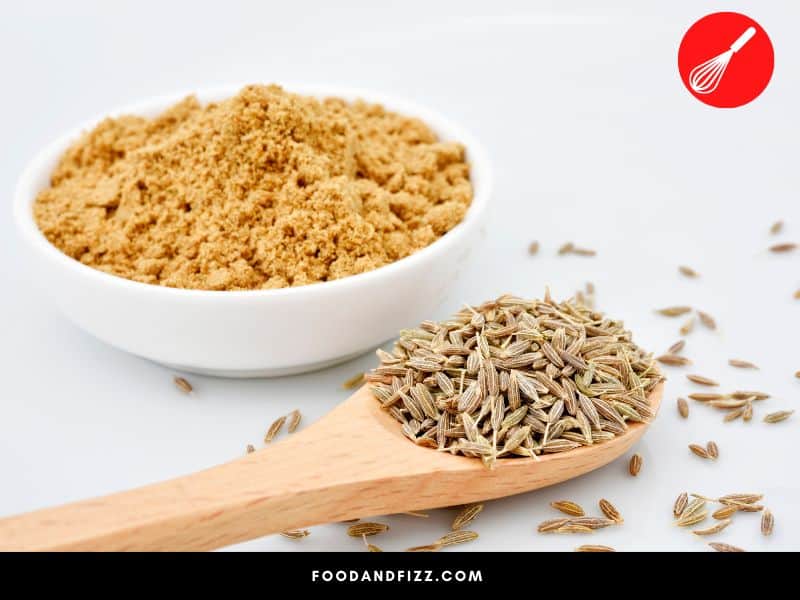
6. Cinnamon
In the U.S., cinnamon is typically used for sweet desserts, but in Thai cuisine, it is most often used in soups and broths, curry, and peanut sauces.
The type of cinnamon used in Thai cooking is Cassia cinnamon, also known as Chinese cinnamon, which comes from the bark of the Cassia tree.
It is more common and cheaper than the other variety, Ceylon cinnamon. Cassia cinnamon is also typically stronger and more flavorful, but also has a higher concentration of coumarin, which when consumed in large amounts, is linked to liver toxicity.
Popular Thai dishes that feature cinnamon include: Massaman Curry, a rich, mildly spicy curry dish with the earthy flavors of cinnamon, cardamom, cumin, bay leaves mixed into a creamy coconut milk base, Thai Noodles with Cinnamon and Prawns, and Thai Braised Beef Stew.
- Characteristics: Reddish brown sticks that look like scrolls
- Flavor or Aroma: Warm, sweet, and aromatic
- Uses: Broths, soups, curry. Used more for savory dishes
- Health Benefits: Helps regulate blood sugar, may help against bacteria and fungi, used for common cold
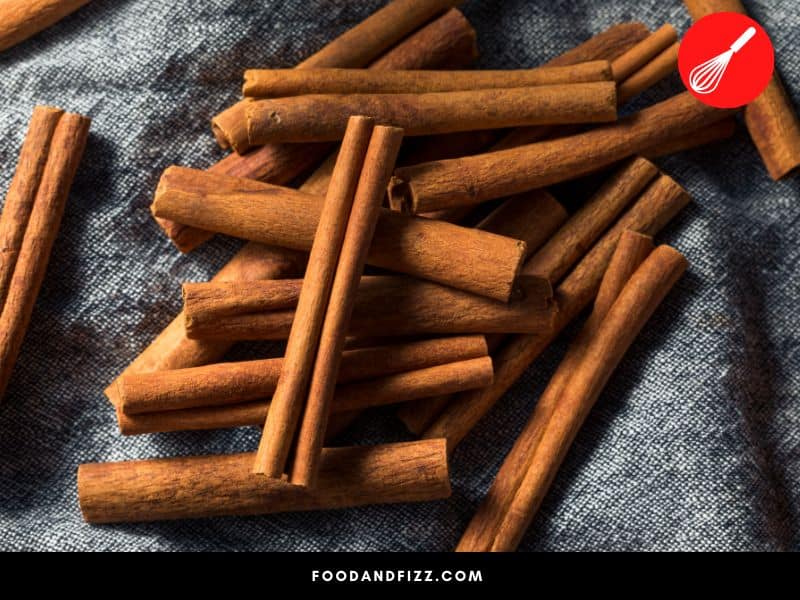
7. Ginger
The use of ginger in Thai cuisine is influenced mostly by traditional Chinese cooking. It is often used in fish and seafood dishes and in vinegar-based sauces, as a topping for congee and steamed fish and as an ingredient in stir fries.
Its spicy flavor and distinctive aroma elevate the flavor of the dish and can help neutralize the sometimes unpleasant “fishiness” in seafood dishes.
- Characteristics: Thin, tan-colored skin, yellow flesh
- Flavor or Aroma: Spicy, slightly sweet, peppery
- Uses: Stir-fries, steamed fish and seafood dishes, soups
- Health Benefits: Helps with nausea,anti-inflammatory, antioxidant, boosts immunity
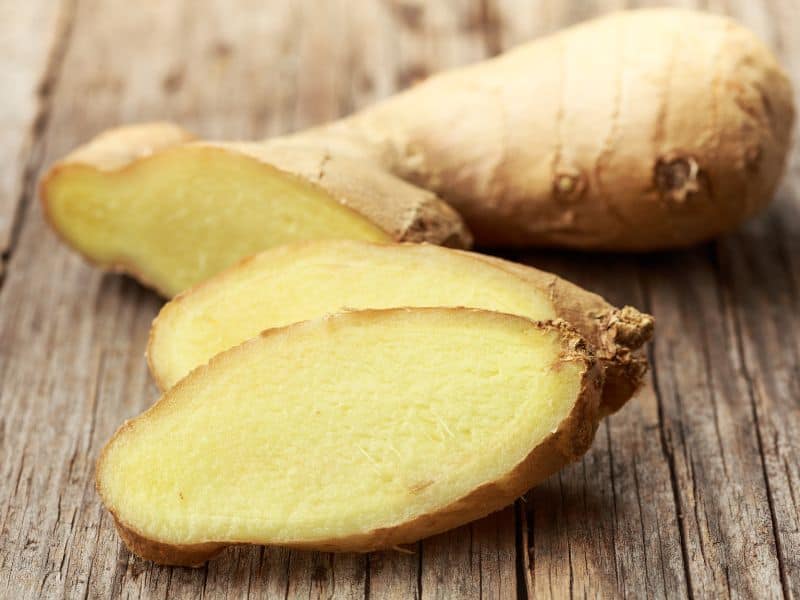
8. Galangal
Sometimes called Thai ginger, galangal resembles ginger in form but has a markedly different flavor. It is related to ginger and turmeric as they are all rhizomes, but is a different ingredient all its own.
While ginger has a warming, spicy but subtly sweet and peppery flavor, galangal’s flavor is more citrusy and some say, piney. It is sharper and more peppery than ginger, has lighter colored skin and is harder than ginger. It cannot typically be grated like ginger and is best when sliced. It is also more fibrous and chewier than ginger.
Galangal is typically harder to find outside of Thailand, unless you go to specialty Asian stores, so most suggest using ginger as a substitute.
While it may work to some degree, it won’t fully capture the complexity that galangal brings to the dish. Ginger of course will impart its own unique flavor to the dish, and it can be good as well, but it just won’t be exactly the same.
One famous Thai dish where galangal shines is Tom Kha Gai, or chicken and galangal soup in a rich, spicy and tangy coconut milk base.
- Characteristics: Woody skin that is paler in color than ginger, hard, fibrous flesh with a pale yellow to ivory color
- Flavor or Aroma: Citrusy but pungent, woodsy, pine-like, sharp, peppery
- Uses: Stir-fries, curries, salads, soup, seafood dishes, tea. Important part of Tom Kha Gai or chicken in galangal soup.
- Health Benefits: Anti-bacterial, anti-inflammatory, high in fiber, high in Vitamin C
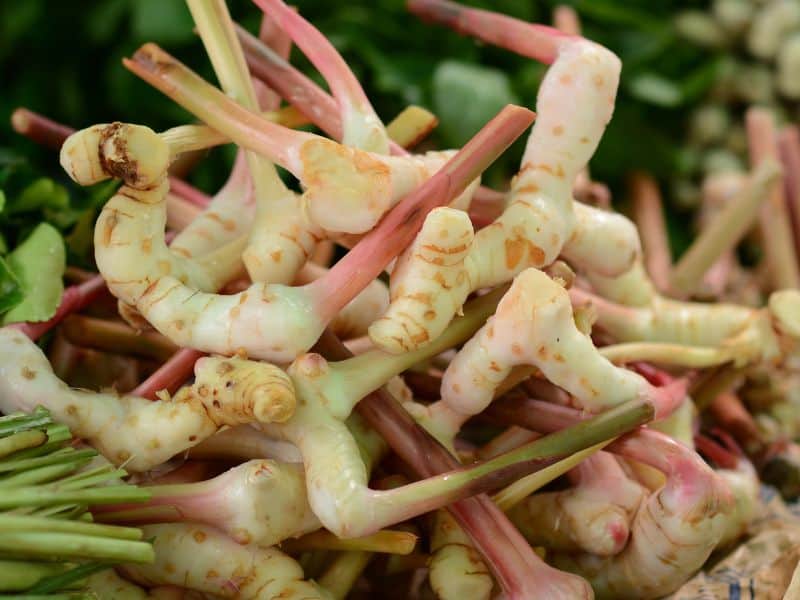
9. Garlic
Garlic is one of the most fundamental ingredients used in Thai cooking, and is used in almost every regional dish. It is used in stir-fries, deep fried as a topping or garnish, and is included in the spice base for most curries and sauces.
It is used in soups and marinades and is also consumed raw in dips and dressings. Raw garlic is also served alongside popular dishes like Khao Ka Mu, or stewed pork leg on rice.
- Characteristics: Small, white round bulb, looks white or pale yellow when peeled
- Flavor or Aroma: Pungent and spicy when raw, sweet and buttery when cooked
- Uses: Stir-fries, deep fried as a garnish, curries, sauces, soups, marinades, dips, dressings, also eaten raw
- Health Benefits: Boosts immunity, helps with cholesterol and blood sugar, antibiotic and antibacterial, supports heart health

10. Bird’s Eye Chilis (Prik Kee Noo)
Thai cuisine is known for its spiciness. This is owing to the many different types of chili peppers that is used in Thai cooking, all with different heat levels and different uses.
The most popular chili used in Thai food is the prik kee noo, also sometimes called bird’s chilis likely because of the fact that birds eat wild chilis and help with spreading the seeds. In Thai though, the name literally means: “mouse dropping chili”, owing to its small size.
They are on average only about one to two inches long, and are thin and slender with a shape like a spear that can either be straight or a bit curved.
They are green when unripe but turn a very bright red when ripe. Despite their small size, they pack a huge punch at around 50,000-100,000 Scoville Units, and are known as one of the spiciest chilis in Thailand.
A variant called prik kee noo suan is even tinier, and even spicier. Prik Kee Noo is used in soups, salads and curry. Green curry is typically made from unripe prik kee noo chilis. These chilis are also used as a condiment in many Thai restaurants, typically sliced and covered in fish sauce
The Scoville scale measures how spicy chili peppers are, as well as condiments or food that contain it. The current world’s spiciest pepper is the Carolina Reaper, which packs in about 2,500,000 Scoville Units! Carolina reapers are used in sauces everywhere, even Blazin’ Buffalo Wild Wings.
If you are interested to learn more about the Scoville scale, check out “How Many Scovilles Do Blazin’ Buffalo Wild Wings Have?” on the site.
- Characteristics: Green when unripe, bright red when ripe, about 1-2 inches in size
- Flavor or Aroma: Extremely spicy at 50,000-100,000 Scoville Units
- Uses: Soups, salads, curry, mixed with fish sauce for a spicy condiment
- Health Benefits: Contains capsaicin which helps with metabolism and digestive health, fights infections, lowers ulcer risk, promotes heart health
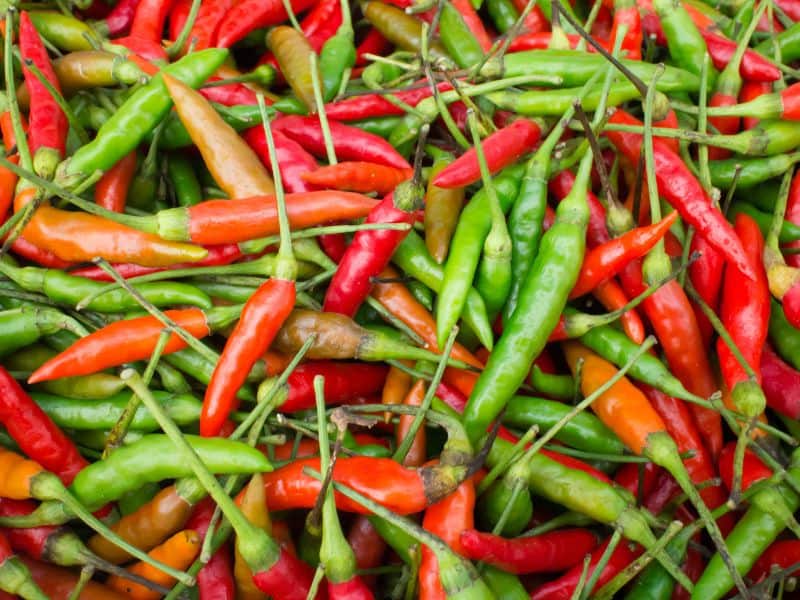
11. Prik Mun Chili
The name means “oily” in Thai, which pertains to its glossy skin. They are red or dark green in color and because they are not too spicy, they are often used for pickling and are often added to condiments like vinegar.
- Characteristics: Red or dark green in color, thick oblong shape and glossy skin, usually around 3-5 inches in size
- Flavor or Aroma: Peppery, subtly sweet, mildly spicy
- Uses: Pickled, condiments, relish
- Health Benefits: Similar to other chili peppers it is anti-inflammatory, helps with weight loss, digestion, contains vitamins and minerals
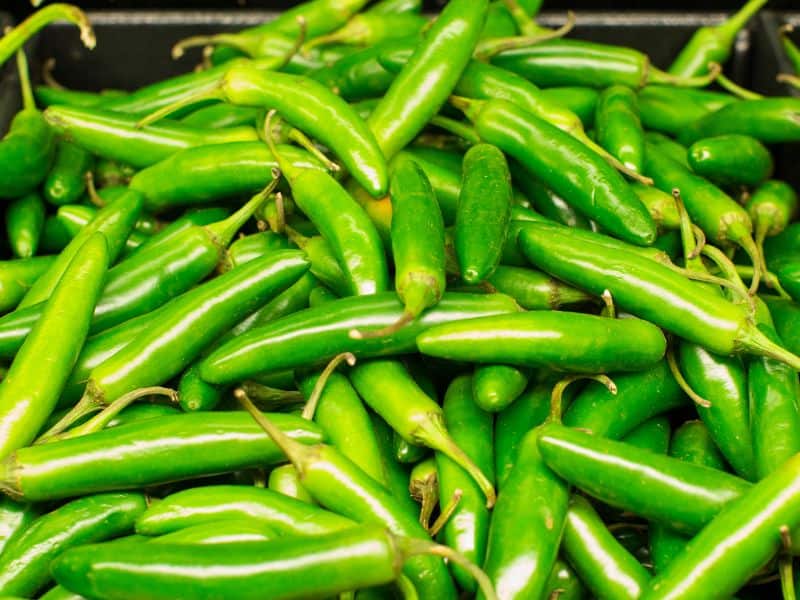
12. Spur Chili (Prik Chee Fah)
Called “spur chili” in the West, its name in Thai translates to: “chili that points to the sky”, because that’s how it grows, pointing upwards. It is not too spicy and is usually the pepper that is used to build up tolerance for heat.
It comes in red or green colors and is usually used for garnishes and decoration because of their pretty appearance. Red spur chilies, when preserved, maintain their bright red color, and they are what give red curry its bright color.
- Characteristics: Red or green in color, 2-4 inches in length
- Flavor or Aroma: Mild to moderately spicy
- Uses: Pickled or fresh, garnish and decoration, red curry
- Health Benefits: Like other chili peppers, it is anti-inflammatory and may help with digestive health
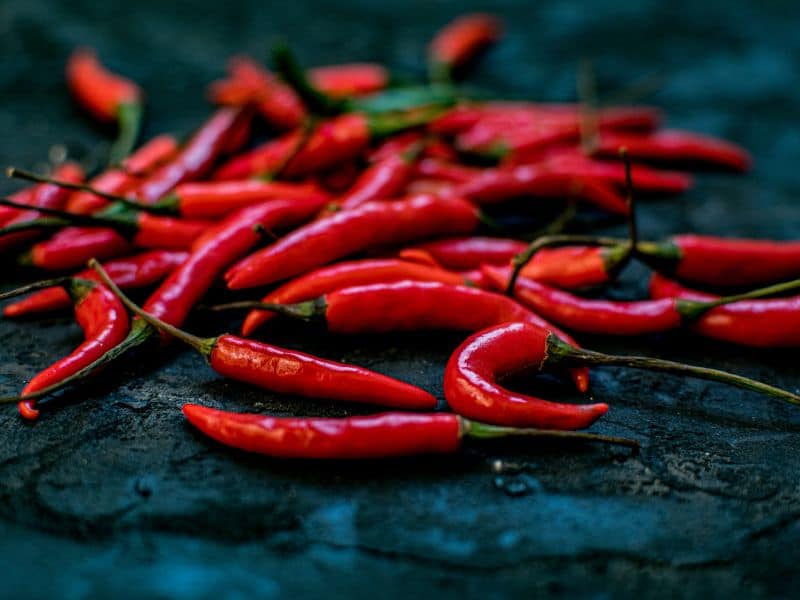
13. Karen Chili (Prik Kaleang)
Along with bird’s eye chilis, Prik Kaleang is one of the spiciest peppers in Thai cuisine, and the heat level in this one builds up gradually. They come in various colors like pale yellow, light green, and red-orange, which show varying degrees of ripeness.
- Characteristics: Light green, yellow, orange, red, common in North Thailand, small in size, bumpy skin
- Flavor or Aroma: Very spicy, builds up gradually
- Uses: Curries, sauces, stir-fries, Pad Thai, and other common Thai dishes
- Health Benefits: Chilis are anti-inflammatory, with vitamins like magnesium and potassium, and vitamins A, B, and C.
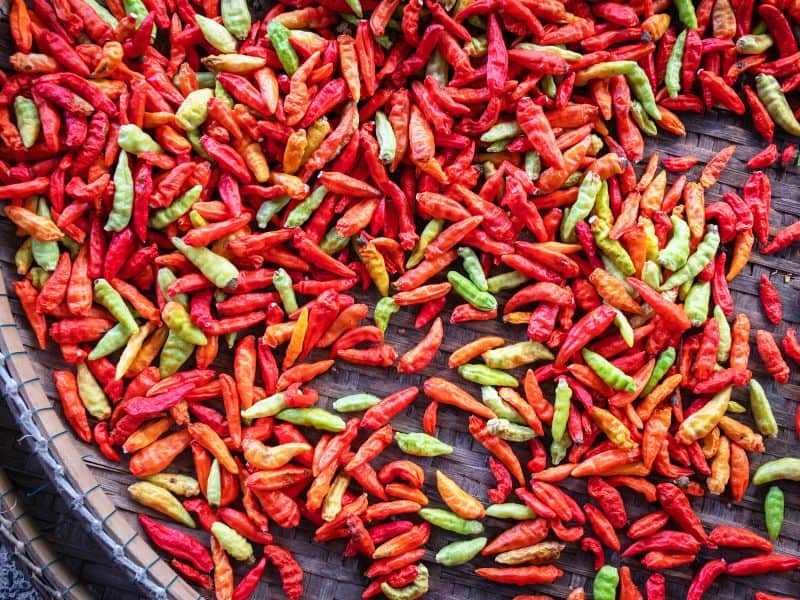
14. Dried Chili Flakes (Prik Bon)
Prik Bon is Thai chili flakes or Thai chili powder. This is usually made with dried bird’s chilis, not fresh. It is a very common Thai condiment that is used for adding extra heat to pretty much anything.
For the DIY-ers, it is also easy to make on your own. Simply buy dried chilis (the smaller the chili, the hotter it is), roast in a pan and then grind to your desired size.
- Characteristics: Powdered spice made with dried chilis
- Flavor or Aroma: Can be spicy if made with bird’s eye chilis or other types of hot chili
- Uses: As a condiment to add extra heat to soups, salads and pretty much anything
- Health Benefits: Helps prevent stomach ulcers and other lifestyle diseases, weight loss, may prevent diabetes
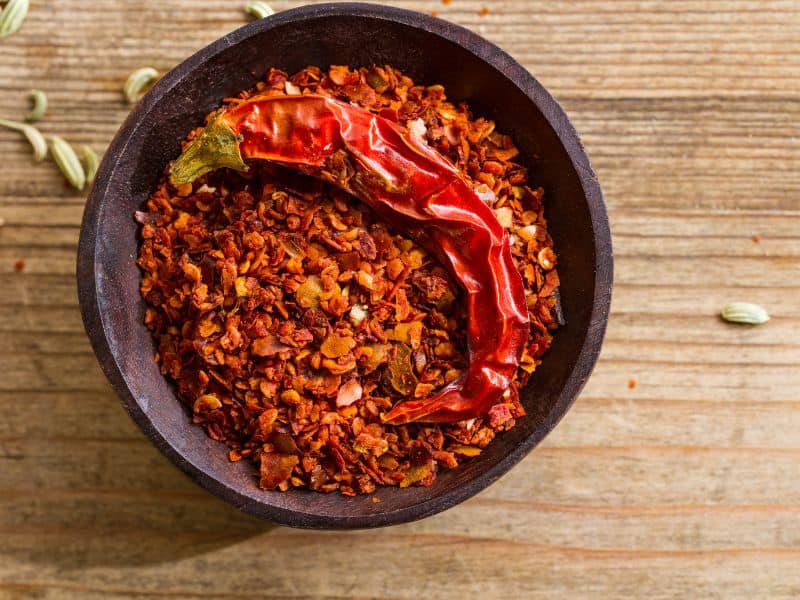
15. Prik Noom
Long green chili that is popular in Northern Thailand. Typical preparation is blackening on open flames to get a smoky flavor, and then mashing into a paste to make a chili dip. This dish is called Nam Prik Noom.
- Characteristics: Long, green chili
- Flavor or Aroma: Moderately spicy
- Uses: Northern Thai green chili dip
- Health Benefits: Capsaicin reduces inflammation and risk of heart disease

16. Sweet pepper (Prik Yuak)
Prik Yuak peppers are not spicy at all and actually taste a little bit sweet. They are also known as the Thai bell pepper or Thai banana pepper.
- Characteristics: 4-7 inches long, light green in color, oblong and waxy skin
- Flavor or Aroma: Sweet and mild, usually 0 on the Scoville scale
- Uses: Can be eaten on their own or used in condiments. Used as stuffed peppers or Prik Yuak Sord Sai
- Health Benefits: Antioxidant, anti-inflammatory, contains lots of vitamins and minerals
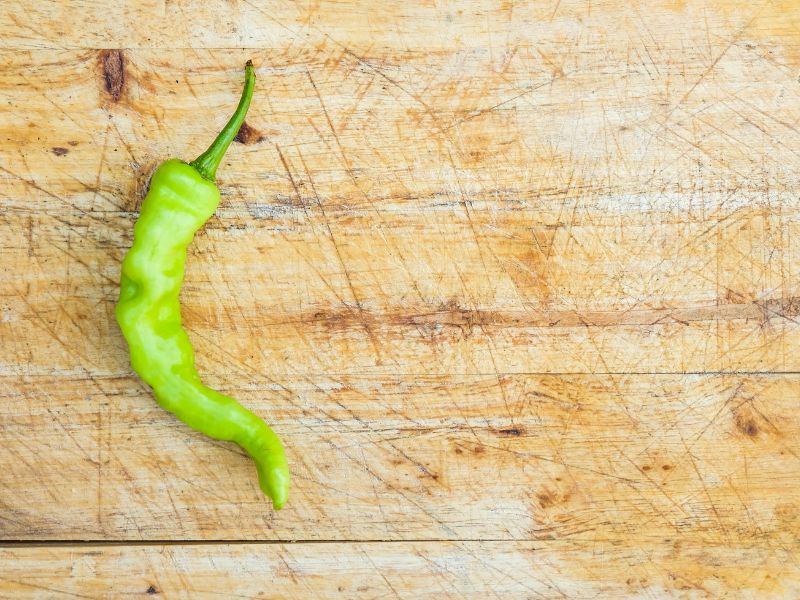
17. Green Peppercorns
Green peppercorns have been used in Thailand for millenia prior to the introduction of chili peppers by the Portuguese. This was the ingredient that was traditionally used to add heat to a dish. They are common in wet markets in Thailand.
- Characteristics: Look like green berries, are actually unripe black peppercorns
- Flavor or Aroma: Piquant, bright aroma, slightly crunchy, mildly spicy
- Uses: Stir-fries, meat-based curry dishes, green curry
- Health Benefits: Rich in antioxidants, helps with digestive health, high in fiber
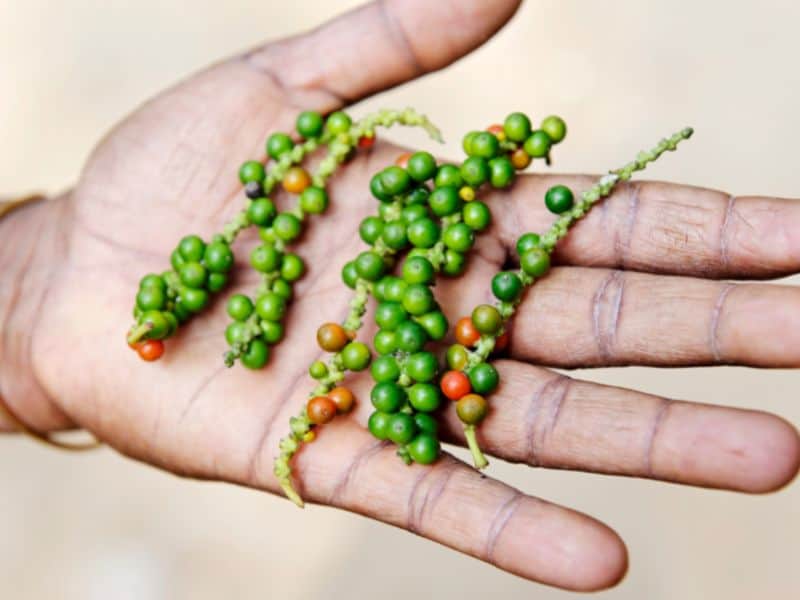
18. White Peppercorns
Unlike other countries, white pepper is actually more common in Thailand than black pepper. Whereas we would normally have black pepper in our shakers at the table, in Thailand, it would normally be white pepper.
White peppercorns are fully ripe red peppercorns with the outer red skin removed through a process of soaking and rubbing. After removing the skin, the peppercorns undergo a process of drying.
- Characteristics: Fully ripe red peppercorns with skins removed, can be whole or dried
- Flavor or Aroma: Earthy, musty, grassy, milder flavor compared to black pepper
- Uses: As a finishing spice, used in regular cooking, stir fries, fried rice, barbecued dishes, light-colored sauces and dishes
- Health Benefits: Prevents gas, helps with digestion, helps with headaches, heart-friendly, helps with colds, anti-microbial, anti-inflammatory.

19. Black Peppercorn
Black peppercorns are produced from unripe, green peppercorns, and are actually the most common type of pepper harvested. They are picked while still green, fermented, and then subjected to a drying process that causes the skin to shrivel up and turn into a dark brown to black color.
- Characteristics: Dried immature green peppercorns
- Flavor or Aroma: Sharp, spicy, woody, intense
- Uses: Seasoning dishes, stir fries, soup, noodles, dishes like Gai Pad Gratiem or Garlic and Pepper Chicken
- Health Benefits: Improves cholesterol, supports brain and heart health, promotes sweating, removes toxins from the body
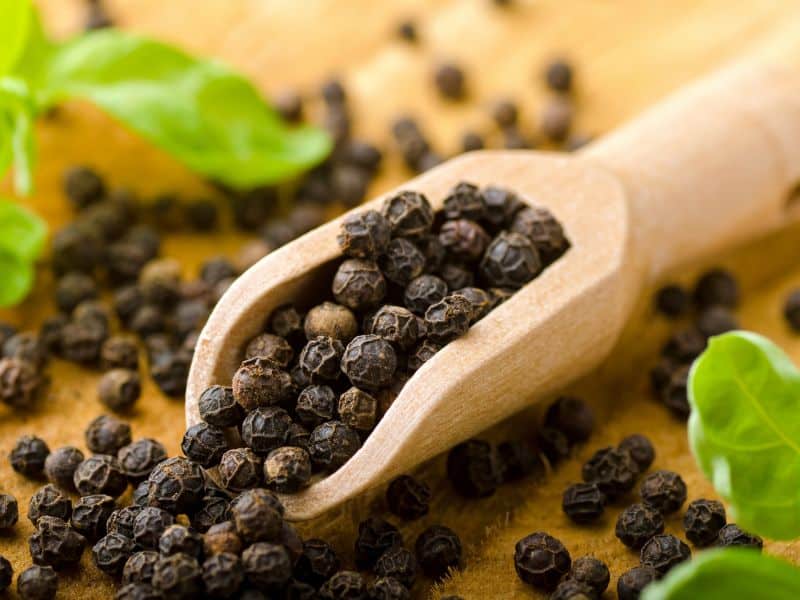
20. Thai Long Pepper
Known in Thailand as “Dee Plee” or piper chaba, this elongated, unique-looking pepper comes from the same family as peppercorns, though they may not look anything alike. They start off with a green color, turn orange when fully ripe, and turn brown when they are dried.
They are sometimes confused with black pepper though their taste is quite different. Fresh long peppers are usually ground up and added to chili and curry pastes, and when added to soups, they can tone down a strong fish taste. Dried ones can be added to laap or larb.
- Characteristics: Green when unripe, orange when ripe, brown when dried, elongated shape
- Flavor or Aroma: Pungent with sweet overtones
- Uses: Curry and chili pastes, meat salads, soup
- Health Benefits: Can help sore throats, reduce gas, stimulate appetite, improve sleep
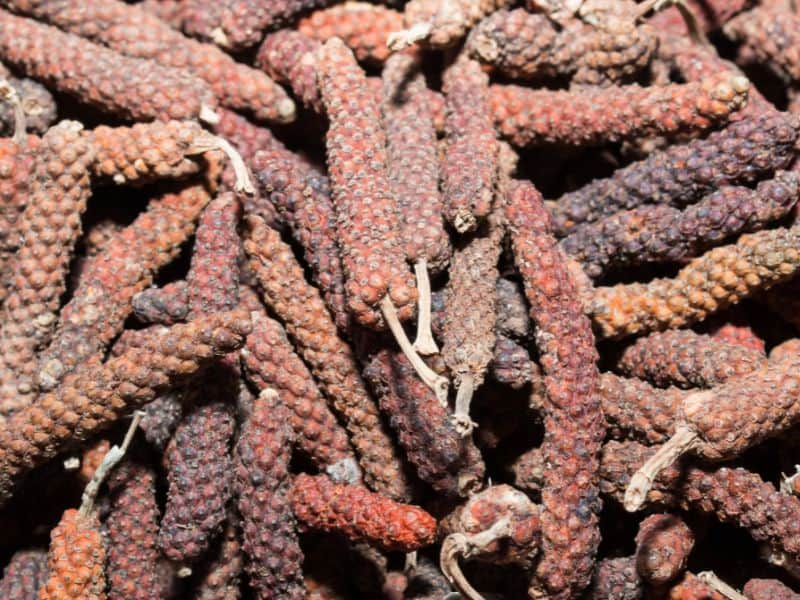
21. Prickly Ash Seed (Makhwaen)
Makhwaen is related to Sichuan peppers and is typically added to Northern Thai dishes for their hot and spicy taste. It is less intense than the Sichuan pepper, with more floral and citrus notes, but it is still spicy, and is often used with long peppers.
- Characteristics: Hard to find but most often seen in Northern Thai dishes
- Flavor or Aroma: Floral, woody, lemon scent, mouth-numbing spiciness
- Uses: Soups and stews, spice blends, dishes like Laap Meuang (minced pork salad), or Naam Phrik Laap (Northern Thai seasoning mix)
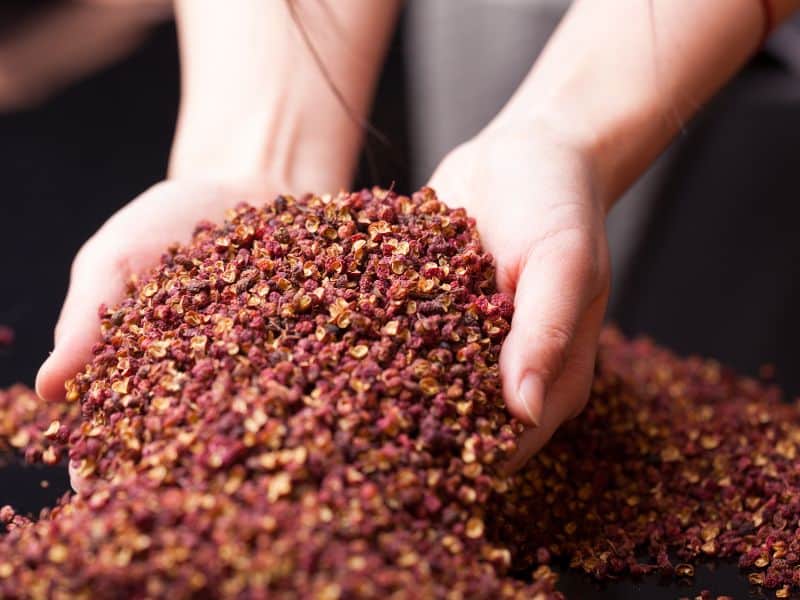
22. Kaffir Lime Leaves
Kaffir lime, also known as makrut lime, is a small citrus fruit native to Southeast Asia. It is small and green with a bumpy texture. In Thai cooking, its leaves are actually the ones that are used more often than the fruit itself. Kaffir lime leaves smell citrusy and aromatic and give soups like Tom Yum their aroma and gives green curry that fresh kick.
- Characteristics: green, hourglass-shaped leaves
- Flavor or Aroma: aromatic, spiced citrus
- Uses: Soups, curry paste, stir-fries, stocks
- Health Benefits: detoxifies blood, boosts immune system, skin and oral health, anti-stress, promotes immunity
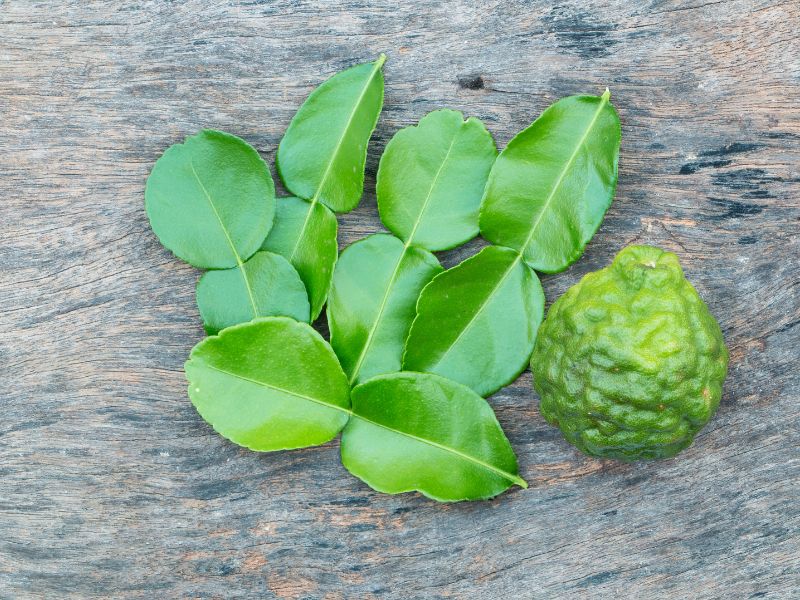
23. Holy Basil (Bai Ga Prow)
Also known as Tulsi, it is a herb that is native to India and is considered sacred in Hindu ceremonial practices due to its association with important gods in Hinduism. Because of its healing and medicinal properties, it is often used in Ayurveda. In Thai cooking, holy basil enhances the heat of the dish.
- Characteristics: Oval leaves with ragged edges, may be green or purple
- Flavor or Aroma: Strong, pungent and peppery
- Uses: Used in stir-fries and noodles to enhance spiciness, dishes like Pad Krapow, or Stir-fried Holy Basil Chicken, or Jungle Curry (Geang Pa)
- Health Benefits: Anti-stress, anti-anxiety, antioxidant and anti-inflammatory
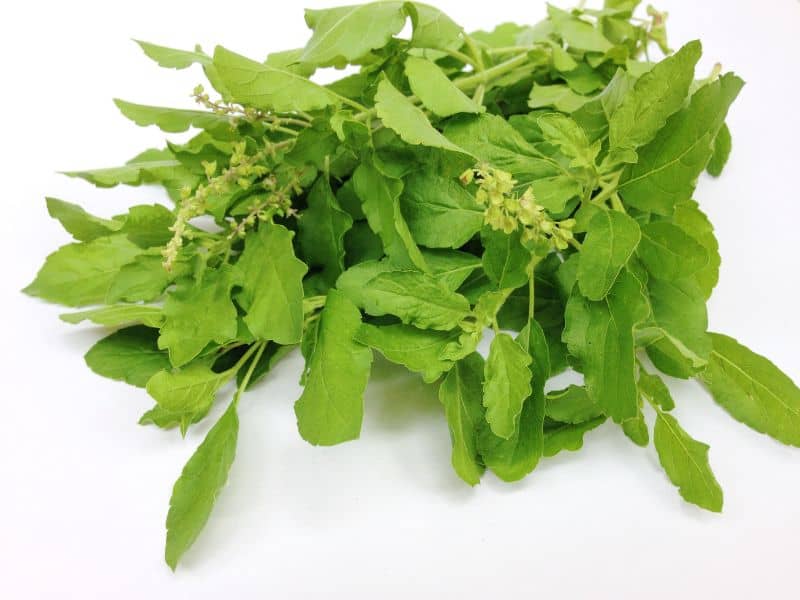
24. Thai Basil (Bai Horapa)
A variety of basil that is native to Southeast Asia, and is sturdier than its Italian cousin. Added as a garnish or during cooking to impart flavor and aroma to the dish.
- Characteristics: Studier, more narrow leaves, almost serrated edges, purple stem
- Flavor or Aroma: Licorice and anise flavor and aroma
- Uses: Stir-fries, noodles, salads, curry, meat salad called Thai Larb
- Health Benefits: Anti-viral, anti-bacterial, anti-fungal, healthy eyes and skin, bone health

25. Lemon Basil (Bai Manglak)
Also known as hoary basil, it has a fragrant and strong lemon scent and fuzzy leaves.
- Characteristics: Green, delicate, looks similar to Italian basil but with hair on its stems and leaves
- Flavor or Aroma: Fragrant lemon scent, sweet and tangy
- Uses: Curries, salads, dip, soup, noodles, dishes like Kanom Jeen Nam Ya (Curry noodles)
- Health Benefits: Contains beta carotene, which is essential for eye health, anti-inflammatory, contains vitamin K for bone health
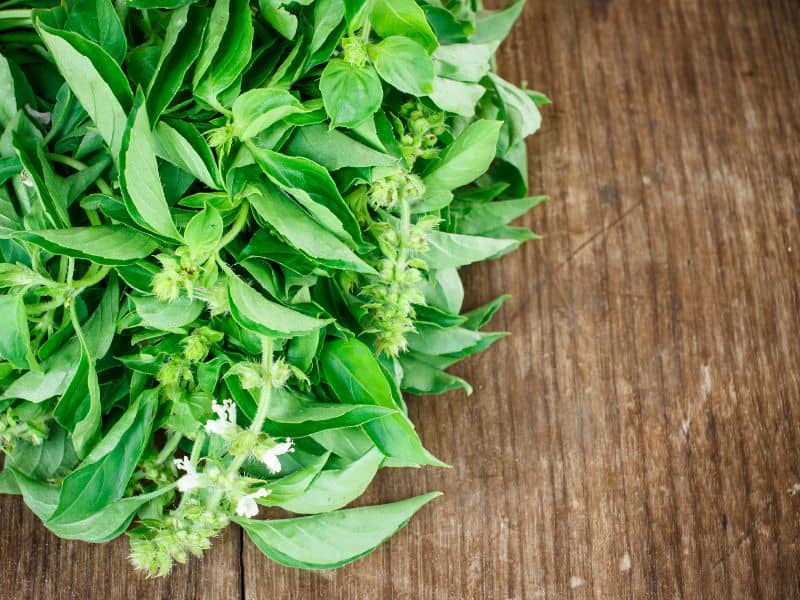
26. Pandan
Known as screwpine in English, pandan is known for its fragrant, grassy aroma and flavor. It is popular to use all over Southeast Asia in both sweet and savory foods as a coloring and flavoring agent, and in Thailand, it is most popularly used in the dish Kai Ho Bai Toeil, or marinated chicken wrapped in pandan leaves and then deep-fried. It is actually one of my ultimate favorite Thai dishes!
- Characteristics: Green, long narrow leaves that look like blades, measure anywhere from 12-20 inches.
- Flavor or Aroma: Fragrant, grassy, hints of vanilla and coconut
- Uses: Added to rice as it cooks, steeped in coconut milk and used in dessert, wrap meats before deep frying, coloring and flavoring agent in cakes and sweet treats
- Health Benefits: May help with blood sugar, and oral health, promote heart health, reduce arthritic pain
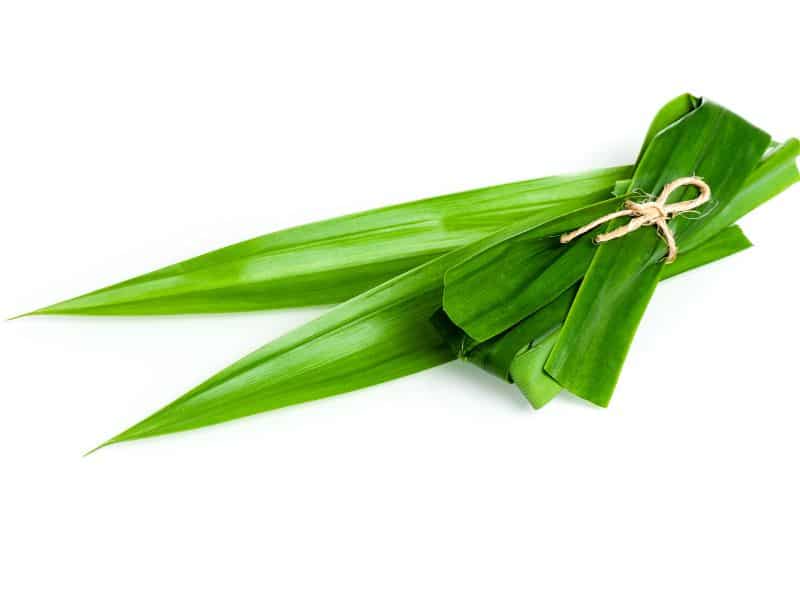
27. Thai Celery
Smaller, thinner, and leafier than its western counterparts, Thai celery is used to flavor soups and stocks, stir-fries, and is used in salads. It also works as a garnish, the same way parsley would be used. The leaves are used just as much as the stems.
- Characteristics: Thin stems, green, jagged leaves
- Flavor or Aroma: Stronger smell and taste
- Uses: Stir-fries, salads, soups, garnish
- Health Benefits: Antioxidant, anti-inflammatory, helps with gout and rheumatism because of its potassium content
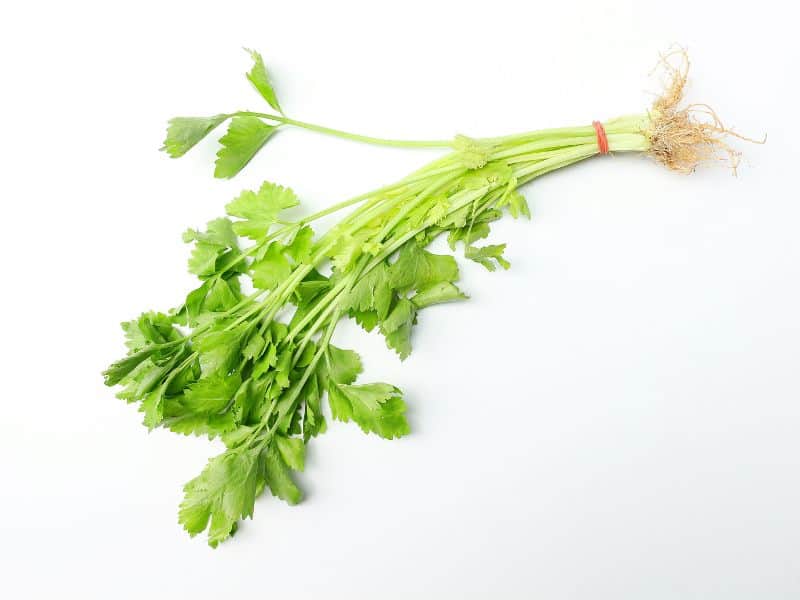
28. Culantro
Although they are related and have similarities in taste, culantro is a different plant from cilantro. Compared to cilantro’s lacy leaves, culantro has long, serrated leaves. It is often seen in curries from North Thailand, as as well as in soups.
- Characteristics: Long, green, serrated leaves, similar to dandelion leaves
- Flavor or Aroma: Similar to cilantro but stronger, usually added during cooking, herbal, citrus, grassy
- Uses: Curries, salads, soups
- Health Benefits: Healthy organ functioning, boosts immunity, reduces inflammation.
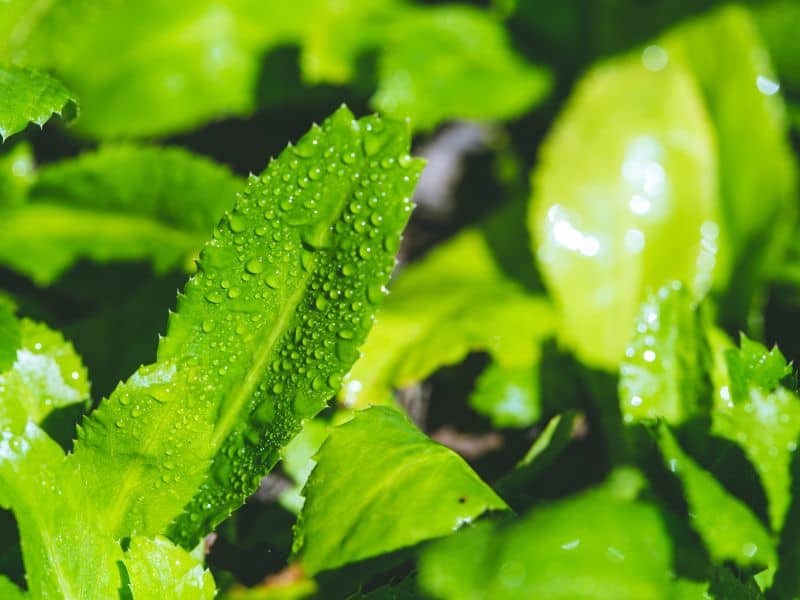
29. Turmeric
A rhizome that looks similar to galangal and ginger, turmeric is often used in Thai cooking in fresh, dried, and powdered forms. Its golden yellow color is what gives yellow curry and Massaman curry their signature color.
- Characteristics: Bulbous shape, ringed skin, and bright orange flesh
- Flavor or Aroma: Earthy, bitter, peppery, mustardy
- Uses: Used for flavoring curries especially Northern curries and Southern curries, yellow curry, Massaman curry
- Health Benefits: Natural anti-inflammatory, lower risk for heart disease, may be preventative against cancer
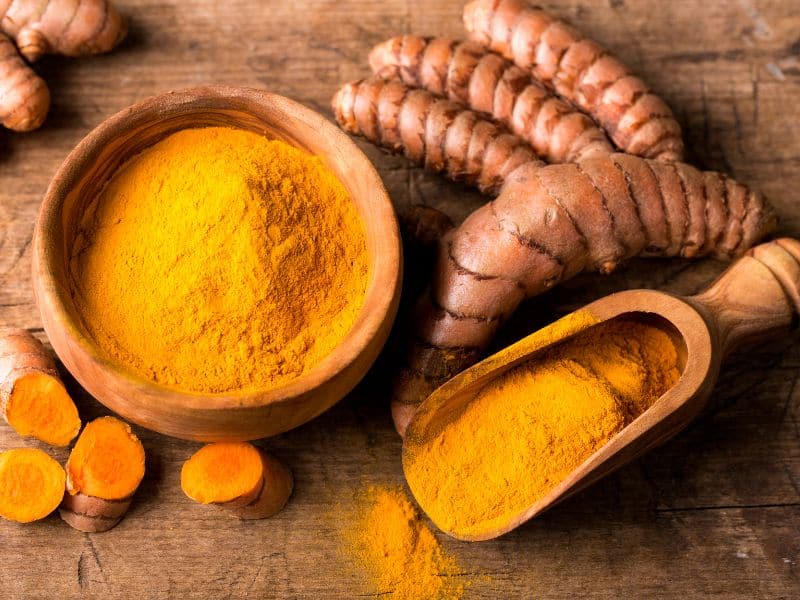
30. Clove
A common spice used in curries and other dishes from the South, as many of their dishes have Middle Eastern and Indian influences, of which cloves play a prominent role.
- Characteristics: Small red-brown spikes with a rounded top, like little nails
- Flavor or Aroma: Warm, subtly sweet and subtly spicy, woody, and some say, smells like Christmas
- Uses: Meat dishes, curries like Massaman curry
- Health Benefits: Promotes healthy liver functioning, digestion, eye health, healthy gut and stomach
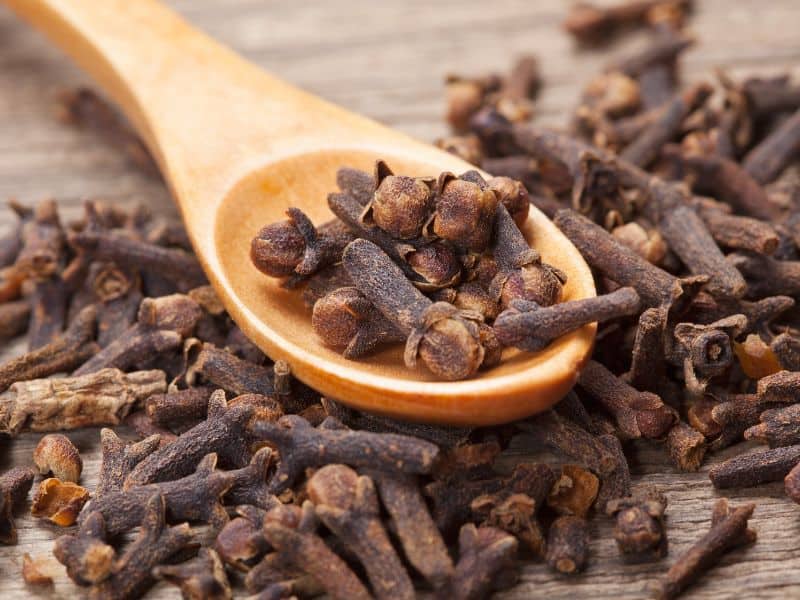
31. Bay Leaves
Bay leaves are the leaves of the laurel tree and are a popular herb in Southeast Asian cuisine. They can be used whole or dried or ground.
In Thai dishes, it is commonly seen in dishes with Indian or Muslim influences, such as Massaman curry.
- Characteristics: Green and shiny when fresh, olive green when dried. Elliptical or oval-shaped leaves
- Flavor or Aroma: Astringent, bitter, almost minty when raw, when cooked, leaves a savory flavor
- Uses: Soups and stews, Massaman curry
- Health Benefits: Good source of vitamins A, B6, and C, boosts immunity, helps manage diabetes
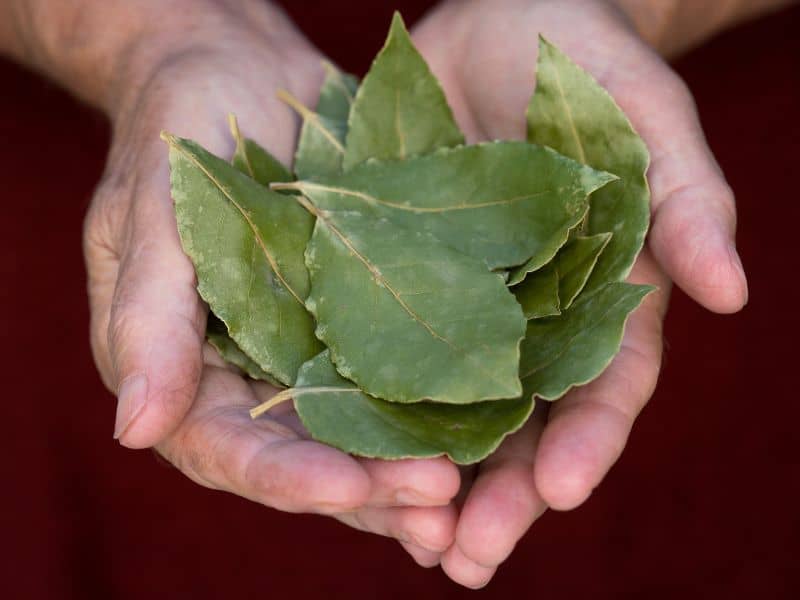
32. Mustard Seeds
Commonly seen in spice mixtures or blends to flavor meat, seafood, and vegetables, and also common in curry spice blends.
- Characteristics: Small round seeds, usually roasted or soaked before use in a recipe, can range in color from yellowish to black
- Flavor or Aroma: Pungent and strong
- Uses: Curry blends and spice blends to flavor meat, seafood, and vegetables
- Health Benefits: Antioxidants, antimicrobial, high in fiber, anti-aging, helps manage cholesterol

33. Fenugreek
Even though the name fenugreek might not be totally familiar, its smell might be. Fenugreek is typically part of the spice blend that comprises curry powder. It is used in Thai cooking mostly for this purpose. In Indian cuisine, fenugreek is called “methi”.
- Characteristics: Yellowish brown, hard and angular in shape
- Flavor or Aroma: Tastes like maple syrup, burnt sugar
- Uses: Ingredient in curry powder
- Health Benefits: Lowers blood sugar, and increases the production of milk in breastfeeding mothers
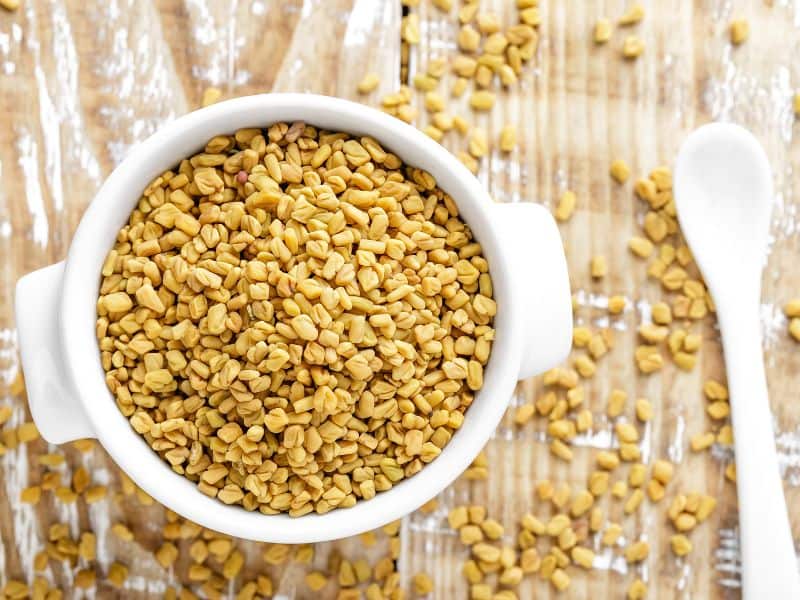
34. Nutmeg
Another ingredient that is added to Thai curry spice blends, notably Massaman curry, but can also be used in recipes involving meat, poultry, seafood, vegetables, as well as baked goods. It is usually used in powdered form.
- Characteristics: Round, egg-shaped seed about an inch big, grayish brown color
- Flavor or Aroma: Nutty, sweet, and warm
- Uses: Added to spice blends for curry, other meat dishes, as well as baked goods
- Health Benefits: Helps improve circulation, and kidney functioning, has anti-depressant properties, helps relieve pain, helps with cognitive function
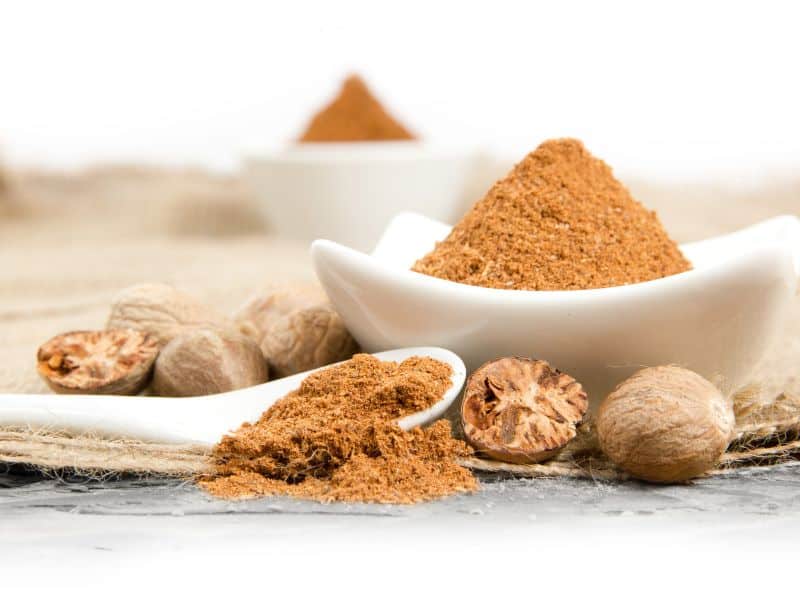
35. Onion
Onions, along with garlic, ginger, and galangal, are used extensively in Thai cooking as part of the flavor base of most savory dishes.
- Characteristics: Can be red, yellow, or white, used extensively in most dishes
- Flavor or Aroma: Pungent, strong, can be spicy when raw but releases sweetness when cooked
- Uses Virtually any savory dish as part of a flavoring base. Can be used raw or cooked
- Health Benefits: Vitamin C, reduces the risk of Alzheimer’s, is anti-inflammatory, reduces cholesterol, and may prevent certain cancers
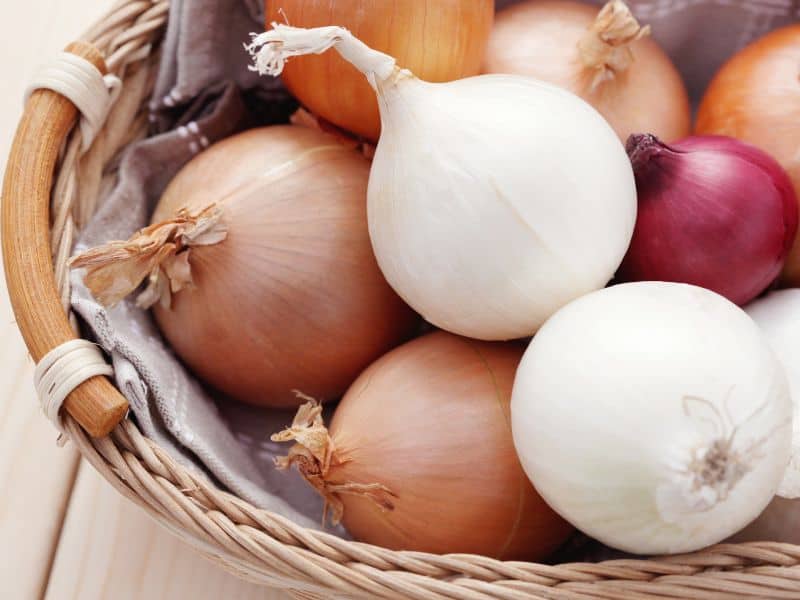
36. Scallions
Scallions or green onions are young onions that are white at the bottom and have green leafy tops. The white part tastes like a regular onion, although it can be a bit milder, while the green tops have a more herbaceous taste and texture. It is used in Thai cooking as a garnish on noodles, salads, and other dishes.
- Characteristics: White at the bottom with green leafy tops
- Flavor or Aroma: Tastes like white onion, but milder
- Uses: Topping or garnish on salads, noodles, and sometimes added to green curry
- Health Benefits: Promotes bone health, helps with blood clotting, contains vitamin K
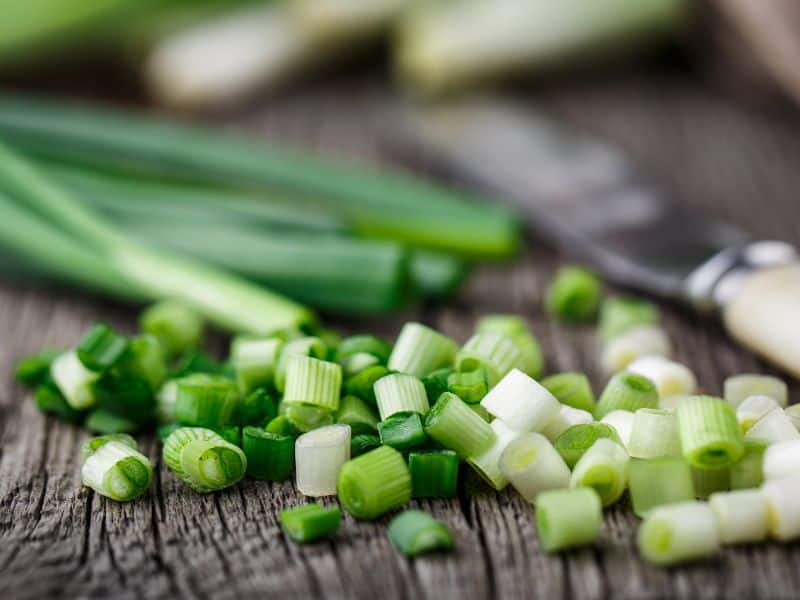
37. Shallots
Shallots are actually more widely used in Thai cooking compared to onions and are actually what help you achieve that authentic Thai taste in dishes.
Red shallots in particular are preferred. They are used in salads, in curry and chili pastes, and even used in sauces and condiments. They can also be fried to a crisp and used as a garnish or topping on dishes.
- Characteristics: Red-pink color, oblong in shape, smaller than a regular onion
- Flavor or Aroma: Milder than onions, sweeter in taste, like an onion with a hint of garlic taste
- Uses: Salads, curry and chili pastes, sauces, condiments, toppings
- Health Benefits: Seasonal allergy relief, bone, and heart health, may help lower blood pressure
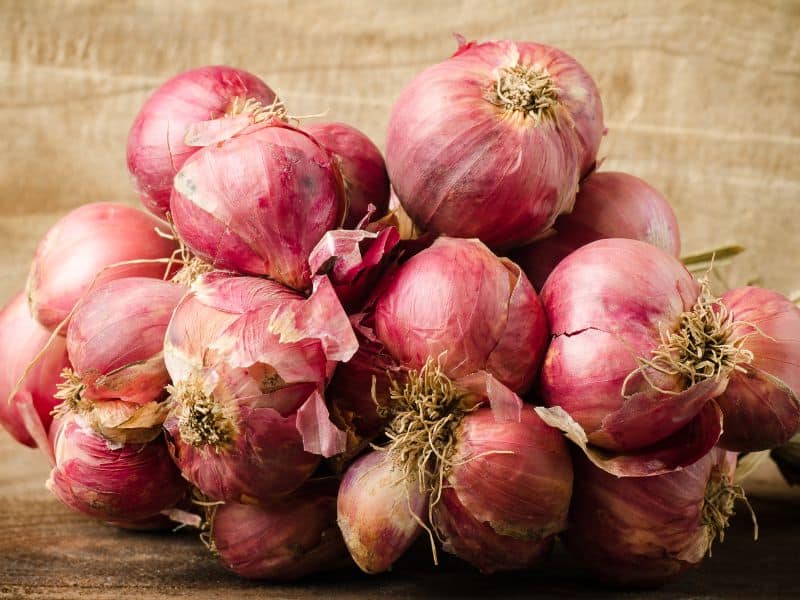
38. Cardamom
Cardamom is used in curries and other dishes in Thailand and is also a valued medicinal herb in some parts of the country. Green and black cardamom is used in a lot of dishes, but a local variety known as luk krawan or Thai cardamom is used as well.
- Characteristics: Thai or Siam cardamom look like straw-colored chickpeas, green cardamom is prominent in Indian cuisine and looks like elongated green pods, black cardamom is larger and darker in color
- Flavor or Aroma: Green cardamom is zesty and citrusy, while black cardamom is smoky and minty. Thai cardamom is similar in flavor to green cardamom but more floral and less pungent
- Uses: Dishes like Larb Nuea(minced meat salad), Kaeng Ka Ree (Thai Indian curry), and noodle dishes like Kuai Tiao Neua (beef noodles soup)
- Health Benefits: Reduces fevers, anti-microbial, helps with digestive and gastrointestinal issues, anti-inflammatory
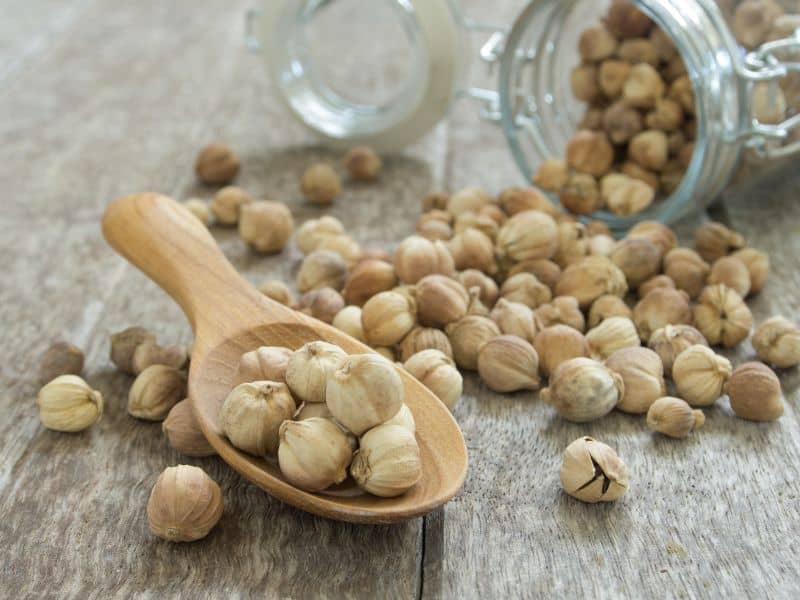
39. Star Anise
Star anise is native to China and Vietnam and is most recognizable for its star-shaped pods. It can be used whole or ground. In Thai dishes, it is typically added to soups.
- Characteristics: Star-shaped pods, an integral component of five-spice powder
- Flavor or Aroma: Fragrant, mildly sweet, licorice-like flavor
- Uses: Whole spice added to soups, ground spice added to curry and dishes like Khao Ka Moo (Braised Pork Leg)
- Health Benefits: Anti-fungal, anti-bacterial, and anti-inflammatory, reduces depression symptoms, protects against stomach ulcers

40. Tamarind
A sweet and sour fruit native to Asia and Africa, tamarind is a staple in many Asian cuisines. In Thai cooking it is an indispensable ingredient; it is used to give a depth of flavor to soups, noodles, curry pastes, and even desserts.
The sour variety of tamarind gives dishes their signature tartness, and the sweet variety can actually be eaten on its own.
- Characteristics: Elongated brown pods with brown flesh and seeds inside, usually sold as concentrate or pastes. Fresh ones that are sweet can be eaten by themselves.
- Flavor or Aroma: Sweet-sour, tangy and acidic, but has hints of caramel and molasses too
- Uses: Tamarind chicken soup, Tamarind Chicken Stir Fry, Pad Thai
- Health Benefits: Antioxidant, mild laxative, helps with colds and fever
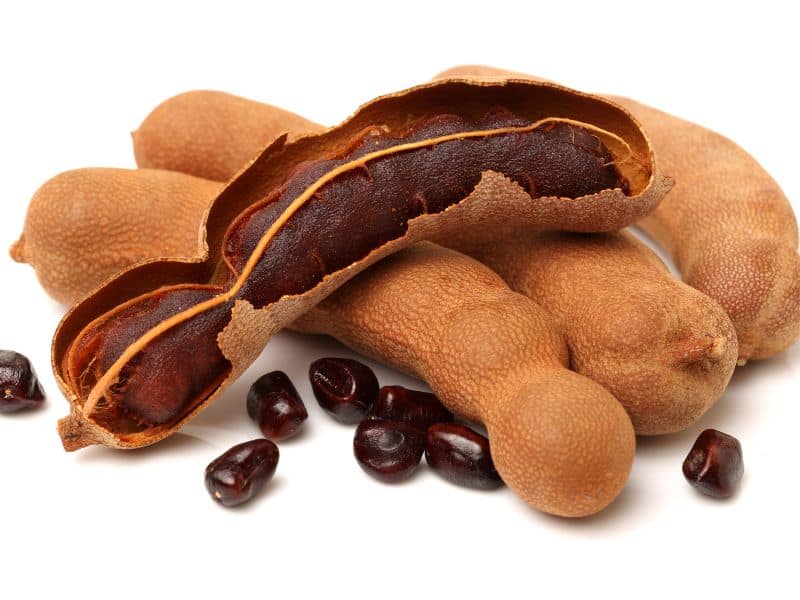
41. Marsh Mint
Mint is used liberally in Thai cooking. It adds freshness and vibrancy to salads, soups, seafood, sauces, drinks, and even desserts.
Marsh mint is typically used, but spearmint and peppermint will work as suitable substitutes.
- Characteristics: Green, elliptical-shaped leaves with a wrinkled surface
- Flavor or Aroma: Aromatic, fresh, cooling
- Uses: Salads, dips, dressings, soup, noodles, steamed fish, and as garnish
- Health Benefits: Helps with fever and digestion
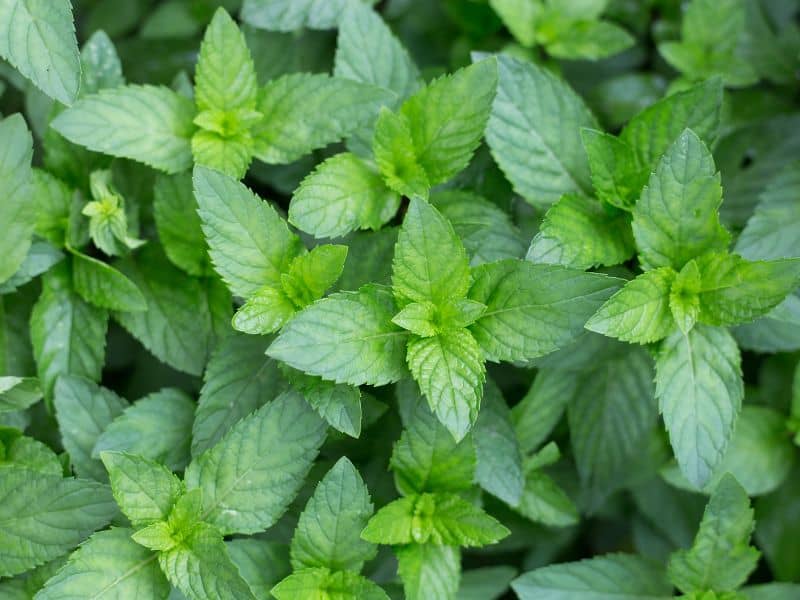
Conclusion to 41 Best Thai Spices
There are many herbs and spices that make up the distinctive taste of Thai cuisine. Some may be more familiar and common to us than others and therefore lend well to easy substitutions and replacements. However, some are truly unique and irreplaceable, and Thai food wouldn’t really be the same without them.

